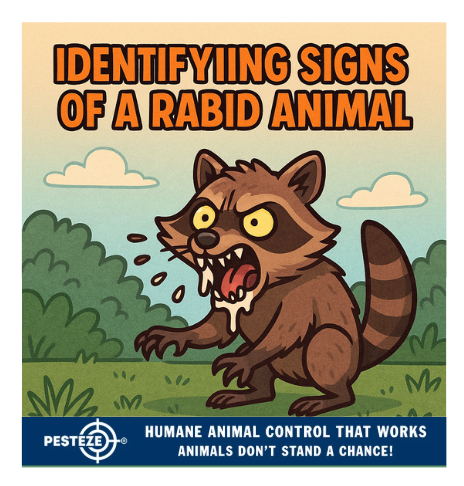IDENTIFYING SIGNS OF A RABID ANIMAL

IDENTIFYING SIGNS OF A RABID ANIMAL
SUMMARY
Rabies is a deadly virus that affects the nervous system of mammals. This guide explains how to recognize the warning signs of rabies in animals, why early identification is critical, and what to do if you encounter a potentially rabid animal.
FEATURES
-
Unusual aggression: Animals may attack without reason.
-
Lack of fear: Wild animals approach humans unnaturally.
-
Disorientation: Stumbling, paralysis, or strange movements.
-
Excessive drooling: Foaming at the mouth is a common sign.
-
Unusual vocalizations: Strange growling, barking, or screeching.
-
Nocturnal animals active by day: Skunks, bats, or raccoons appearing at odd times.
GUIDE DESCRIPTION
Rabies is one of the most serious zoonotic diseases, and once symptoms appear, it is almost always fatal. Identifying a rabid animal quickly helps protect you, your pets, and your community from exposure.
One of the clearest signs is unusual aggression. Rabid animals may suddenly bite, chase, or attack without provocation. This behavior is especially concerning in animals that are typically shy or calm.
Another indicator is a lack of fear. Wild animals that normally avoid humans—such as raccoons, foxes, or bats—may approach people, pets, or populated areas. This behavior is highly abnormal and a strong warning sign.
Disorientation and paralysis are also common. Rabid animals may stumble, appear confused, drag their legs, or display jerky movements. In advanced stages, paralysis can set in, leaving the animal unable to move normally.
Excessive drooling or foaming at the mouth is a hallmark symptom. This happens because rabies affects the nervous system, making it difficult for animals to swallow.
Infected animals may also produce unusual vocalizations. Dogs might bark hoarsely, raccoons may screech, or other animals may make strange, continuous noises not typical of their species.
Another critical sign is seeing nocturnal animals active during the day. Skunks, raccoons, bats, or foxes wandering in daylight hours often signals something is wrong, and rabies is one possibility.
If you see an animal exhibiting these symptoms, it’s vital to avoid contact. Do not approach, feed, or attempt to capture the animal yourself. Instead, keep pets and children away and contact local animal control immediately.
If you suspect you or your pet has been bitten or scratched by a rabid animal, seek medical or veterinary attention right away. Rabies can only be prevented with immediate post-exposure treatment, but once symptoms appear, it is almost always fatal.
Recognizing these signs of rabies and acting quickly can save lives and stop the spread of this dangerous disease.
- Saneeth Thota


Comments 0